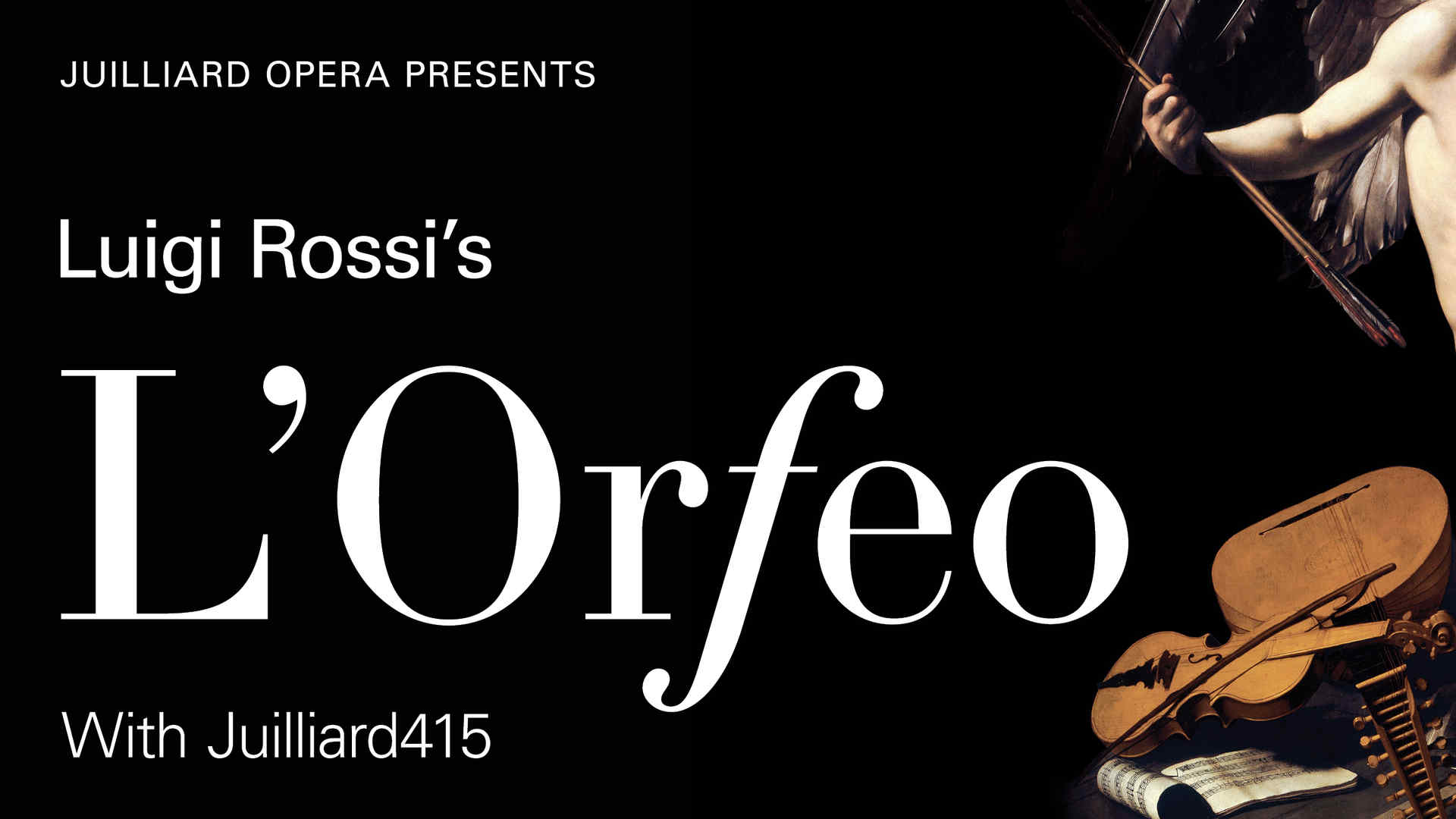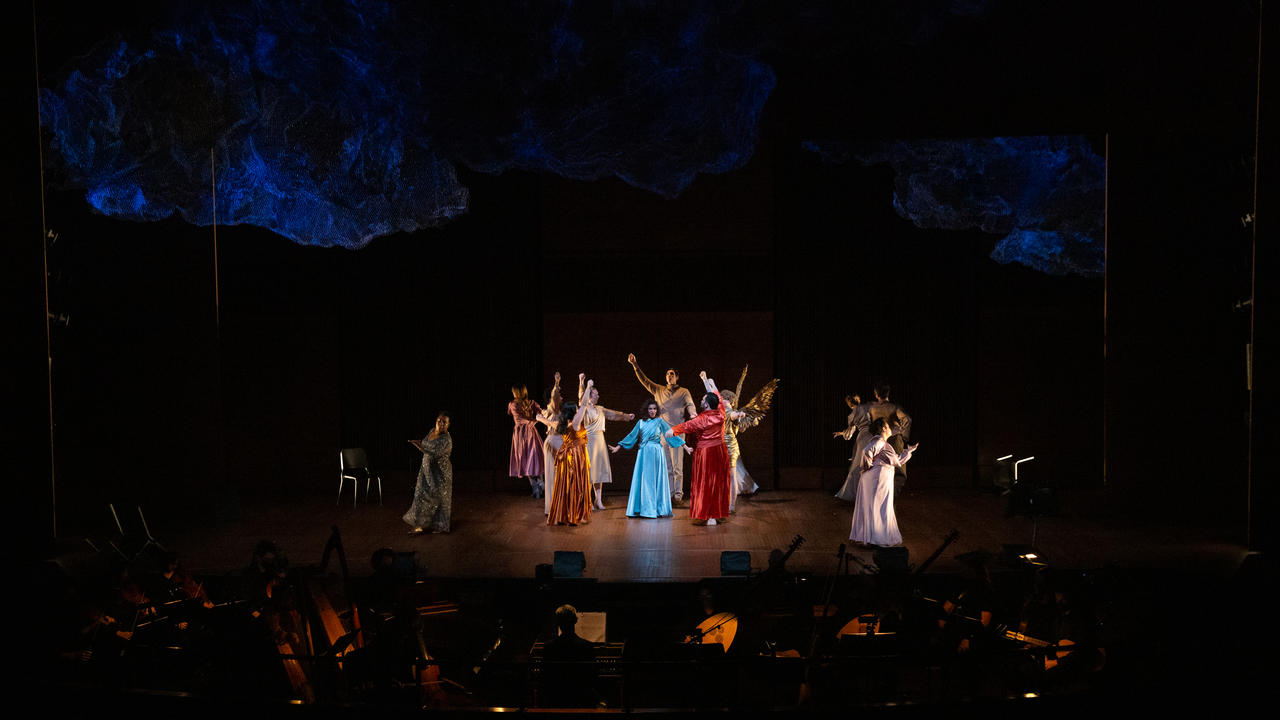
By Thomas May
With his L’Orfeo of 1647, Luigi Rossi (c. 1597–1653) carries the distinction of writing the first opera officially sponsored by the French court. L’Orfeo ranks among the earliest efforts to export the still-young art form from its native Italy to France. For a mixture of artistic and political reasons, these attempts met with considerable resistance before a new hybrid that could accommodate existing traditions of ballet and spoken tragedy emerged successfully under the auspices of King Louis XIV.
Despite its vivid musical and theatrical interest—let alone its historical significance—L’Orfeo remains a rarely encountered work. Only a very few productions, mostly associated with universities or conservatories, have been staged in the U.S.; Juilliard’s presentation, which opens November 10, is believed, according to music director Avi Stein, to be the New York stage premiere.
L’Orfeo revolves around a large cast, and the score—in contrast, say, to operas by Handel—calls for a striking number of ensembles; monologues are the rarity here. It is precisely this ensemble quality, Stein says, that made L’Orfeo an apt choice for Juilliard Opera to re-emerge “after a year and a half of not being able to make music together.” Stage director Mary Birnbaum adds that the ensemble emphasis shaped her concept of the physical production, which starts with the entire cast assembled in a concert shell as if during a pandemic performance, until the shell breaks apart to reveal the underworld.
Rossi had already started to leave a mark on French taste through the dissemination of his vocal music prior to coming to Paris in 1646. After enduring various delays, L’Orfeo premiered on March 2, 1647, at the Théâtre du Palais-Royal, one of the first in France to boast a proscenium arch and capable of seating 3,000 (!) spectators. Librettist Francesco Buti—a key figure in the importation of Italian culture to the royal French court—expanded the familiar story of Orpheus and Eurydice to embed various subplots and an expanded cast of classical deities.
An important role is given to the decidedly unwanted suitor Aristaeus, for example, who tries to subvert Eurydice’s marriage to Orpheus with the help of Venus. In a scene culminating in his suicide, the deceased Eurydice taunts him, making what seems to be the first apparition of a ghost in the history of opera. (Buti draws on the Orpheus tradition found in book four of Virgil’s pre-Aeneid poem Georgics, in which the beekeeper Aristaeus discovers he has angered the supernatural powers by causing the death of Eurydice.)
Rossi and Buti’s version followed Monteverdi’s L’Orfeo, which is much more familiar to 21st-century audiences—by four decades, and in that time much had changed. Rossi and Buti’s treatment is far removed from the tone of that earlier work, freely mixing tragic and comic elements in a way reminiscent of Monteverdi’s final opera, L’incoronazione di Poppea (1643). Along with a comic satyr, the opera even includes an interlude in which Juno tries to make Proserpine jealous of Eurydice so she will persuade her husband Pluto to listen to Orpheus. Stein compares this tone to Shakespeare’s approach, where “the fool is the smartest guy in the room: The comic characters are silly, yet they are the ones who show that emotions lead to ruin.”
For Birnbaum, L’Orfeo explores “the idea that destiny happens to you whether you like it or not, and no matter how much humans try to have control over their environment and future.” Despite the tightly staged concert we witness at the beginning of the show, “mayhem ensues” with the appearance of bad omens.
Reportedly taking around six hours to perform when it opened, L’Orfeo was an undertaking of grandiose dimensions. The 1647 premiere enlisted the contributions of the choreographer Giovanni Battista Balbi for its dancing chorus and the star stage designer Giacomo Torelli, a master of special effects, who created a spectacular machine to depict Apollo descending in his chariot of fire. Yet L’Orfeo provoked a mixed reception. France’s opera skeptics objected in principle to the lack of “realism” in Italian opera. The expatriate critic Charles de Saint-Évremond, for example, scornfully defined opera as “an odd medley of poetry and music, wherein the poet and musician, equally confined one by the other, take a world of pains to compose a wretched performance.”

More specifically, the vast expenses needed to fund this extravaganza stirred up xenophobic resentment from the aristocracy against the mastermind behind the commission, Cardinal Jules Mazarin. A diplomat and, practically speaking, ruler of France as advisor to the regent Queen Anne of Austria (likely his lover), Mazarin had been born Giulio Mazzarino in Italy and was tutor to her son, Louis XIV, then still a minor. The cardinal found his path to power at the French court, where he could simultaneously continue his activity as a patron of the arts, in particular championing Italian opera.
Mazarin’s tenure took place during a period of minor civil wars in which the nobility challenged the king’s growing power and authority. The lavish sums disbursed for the L’Orfeo production were cited as proof of the royal court’s decadence and wastefulness. Still, when Louis XIV himself took on the reins, it was his court that established the prototype for French opera through support of Jean-Baptiste Lully (another transplanted Italian).
Cardinal Mazarin gave Francesco Buti responsibility as a kind of impresario, and the librettist brought other Italian composers to Paris as well. Yet while he crafted L’Orfeo expressly for Paris, the opera was composed in Italian and draws on traditions specifically associated with Rome—including the emphasis on high voices, with male castratos cast as Orpheus, Aristaeus, and other smaller roles. “They were importing the genre of opera wholesale,” Stein explains, “along with other kinds of music, such as cantatas.” He adds that the intended audience was cosmopolitan and would have been accustomed to hearing pieces in a foreign language.
What was tailored for the French was the convention of framing the main story with a heavily allegorical prologue and epilogue. Originally, these parts of L’Orfeo functioned as a sycophantic paean to the child-king Louis XIV. Stein has replaced these with short pieces from Rossi’s vast catalogue of madrigal-like vocal pieces. These ruminate on pertinent themes of love as a battlefield of emotions that tear us apart (a popular 17th-century topic). The duet Ai sospiri, al dolore replaces the original epilogue with an ironic assent to love and the turmoil it entails.
Along with the allegorical framework, Stein has made other cuts in the sprawling score. But since the surviving manuscript lacks important information, he has added some instrumental ritornellos. “Most 17th-century operas seem to be missing a huge part of their instrumental music in the manuscripts,” he explains. “My guess is that these functional instrumental pieces, which allow people to come on and offstage, were probably added much later and for the occasion, once the staging was settled.” Stein’s interpolations come from various sources, since only a single independent instrumental piece by Rossi has survived. These include excerpts from Rossi’s earlier opera (Il palazzo incantato) as well as pieces by the (unrelated) contemporary Michelangelo Rossi and the Neapolitan composer Andrea Falconieri.
Along with a core band consisting of a string quartet, Stein has created an expansive continuo section of two harpsichords, organ, three theorbos, two Baroque harps, and five Baroque guitars. The harps are a nod to musical tastes in Rome and Naples; Rossi’s wife, Costanza de Ponte (who died while Rossi was working on L'Orfeo), was hailed as one of the finest harpists of the era.
Overall, Rossi was admired for his ability to juxtapose varied stylistic registers, freely moving between recitative and arioso and punctuating the drama with arresting harmonies. Stein credits him with a special penchant for tunefulness, which is especially evident in the scenes devoted to Orpheus and Eurydice (much more extensive than in Monteverdi). The story of these lovers has remained a constant inspiration throughout the history of opera. And it reflects our current situation with uncanny resonance. “If we ask what it is to have hope for a future generation in a hopeless time,” Birnbaum says, “I think of Orpheus and this idea of music as his form of hope against death. Music is what brings him a second chance. It is the tool of hope in this dark time.”
This article was adapted from the program note.
Thomas May is the English-language editor for the Lucerne Festival and writes about the arts for a wide variety of publications; his books include Decoding Wagner and The John Adams Reader